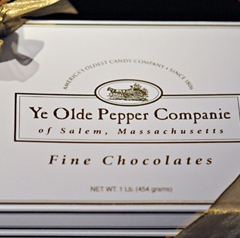Despite the most recent tendency by retailers to transform Thanksgiving into an insane Christmas shopping spree — brown Thursday to some — this special very American holiday still remains dear to my heart. Come on, how often do we can a chance to celebrate tolerance and diversity in this country’s history?
Then there’s the food, of course. From what I’ve been able to discern, that first Thanksgiving was a bit different that the traditional menu of turkey, stuffing, mashed potatoes, cranberries, green bean casserole and pumpkin pie — the inspiration for Norman Rockwell’s Freedom from Want illustration.

|
| Bernie Pacyniak |
The Pilgrims and Indians celebrating the harvest feast were most likely dining on a smorgasbord of foodstuffs, such as venison, wild turkey, duck, lobster, cod, eel, oysters, pumpkins, Indian corn, carrots, beans, plums, walnuts, chestnuts and acorns.
Sweet treats really didn’t play a role since the Pilgrims didn’t have sugar at the time. Granted, there might have been corn meal porridge, but that’s the extent. Well, that got me to thinking about when the first candies did make an appearance here in the States.
According to most accounts, rock candy was the most common treat available in the early 18th century, and then, only for the well-to-do. The first candy manufacturer turning out products commercially didn’t turn up until 1806, appropriately in Salem, Mass.
Just directly across the famed House of the Seven Gables (yes, the one Nathaniel Hawthorne wrote about in 1851) stands Ye Olde Pepper Candy Companie — America’s oldest candy company.
Now many of you have may heard about the company and/or even visited this place. I don’t doubt that Candy Industry has written an article or two about them, although I don’t recall it happening during my 12-year watch.
But given that Thanksgiving — apart from the overeating and football games — warrants some reflection on the bounties we’ve received, I thought delving into the history of this treasure deserved a few words.

|
You see, Ye Olde Pepper Companie traces its lineage to an English woman named Mary Spencer, who as the candy company’s website proclaims “was shipwrecked and landed in Salem in a rather destitute condition.”
Not a good start. It’s almost as bad as being accused of witchcraft — although that was another era. In any case, Spencer tried her best to make a living for herself and her son. But as the story goes, when her neighbors learned that Spencer knew how to make candy, they all got together and purchased a barrel of sugar for her. Little did they know that this single act of kindness would produce the "Salem Gibralter," said to be the first candy made and sold commercially in America and carried around the world by sea captains and their crew.
Mrs. Spencer eventually sold the business to John William Pepper, who not only expanded the business but introduced a new sweet, Black Jack, (an all-natural stick candy made from black strap molasses).
During the late 1800s, the first Burkinshaw went to work at the historic candy company. Horatio Alger-like, he purchased the company and all the recipes dating back to Spencer after working his way up. Since then, four generations of Burkinshaws have been running the operation. Today, Bob Burkinshaw together with his wife and son, Craig, keep the place humming.
There’s a blog called www.The Distracted Wanderer.com written by Linda Orlomoski that goes into much great detail about the place, including some wonderful images of the store, its products, its equipment and so on.
It also has a video snippet about how the famed Salem Gibralters are made, including a demonstration of hand pulling the candy. It’s cool stuff and definitely worth a visit during this Thanksgiving holiday. In the end, amongst all the things we should be thankful for, working in this industry should be one of them. Lest I forget, the entire Candy Industry staff wishes all our readers and supporters a blessed and bountiful Thanksgiving. Sweet eats.

